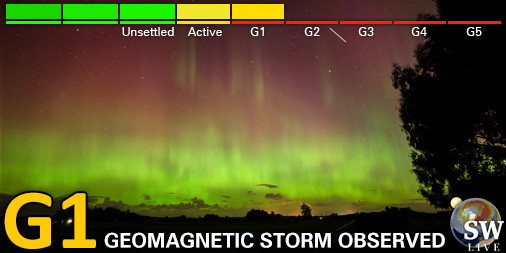Viewing archive of Wednesday, 12 February 2020
Daily bulletin on solar and geomagnetic activity from the SIDC
Issued: 2020 Feb 12 1231 UTC
SIDC Forecast
Solar flares
Quiet conditions (<50% probability of C-class flares)
Geomagnetism
Quiet (A<20 and K<4)
Solar protons
Quiet
| 10cm flux | Ap | |
|---|---|---|
| 12 Feb 2020 | 070 | 008 |
| 13 Feb 2020 | 071 | 010 |
| 14 Feb 2020 | 070 | 008 |
Bulletin
The solar activity has been quiet over the past 24 hours. The visible solar disc is spotless and the X-ray flux is below B-level. The solar activity is expected to remain at low levels over the next 24 hours.
No earth-directed coronal mass ejections (CMEs) have been observed in the available coronagraphic imagery. The greater than 10 MeV proton flux was at nominal values.
The influence of the high-speed stream coming from the positive polarity coronal hole has dropped on February 11 around 19:30 UTC when the phi angle switched to the negative sector. The solar wind parameters remained, however, slightly enhanced. The wind speed first decreased up to 350 km/s to then re-increase up to 420 km/s, the total interplanetary magnetic fields was below 6 nT, and the southward magnetic component fluctuated between -4.5 nT and 5.0 nT. The solar wind conditions are expected to remain slightly enhanced for the next 24-hour period. Solar wind coming from the equatorial coronal hole (negative polarity) that reached the central meridian on February 9, may then contribute to the solar wind enhancement in about 1-2 days.
The geomagnetic conditions were quiet with few short periods of unsettle condition observed in Dourbes station (K-Dourbes = 3). We expect the geomagnetic conditions to remain mostly quiet with some short sporadic periods of unsettled condition for the next days.
Today's estimated international sunspot number (ISN): 000, based on 22 stations.Solar indices for 11 Feb 2020
| Wolf number Catania | 000 |
| 10cm solar flux | 071 |
| AK Chambon La Forêt | 008 |
| AK Wingst | 007 |
| Estimated Ap | 006 |
| Estimated international sunspot number | 000 - Based on 24 stations |
Noticeable events summary
| Day | Begin | Max | End | Loc | Strength | OP | 10cm | Catania/NOAA | Radio burst types | |
|---|---|---|---|---|---|---|---|---|---|---|
| None | ||||||||||
Provided by the Solar Influences Data analysis Center© - SIDC - Processed by SpaceWeatherLive
All times in UTC
Current data suggests there is a high possibility for aurora to appear at the following high latitude regions in the near future
ReykjavikCurrent data suggests there is a moderate possibility for aurora to appear at the following high latitude regions in the near future
TórshavnOulu, Rovaniemi, Sodankylä, Utsjoki
Kirkenes, Tromsø, Trondheim
Murmansk
Kiruna, Luleå, Umeå
Current data suggests there is a slight possibility for aurora to appear at the following high latitude regions in the near future
KuopioBergen
Arkhangelsk
Sundsvall
Current data suggests there is a slight possibility for aurora to appear at the following middle latitude regions in the near future
TamperePetrozavodsk
Latest news
Latest forum messages
Support SpaceWeatherLive.com!
A lot of people come to SpaceWeatherLive to follow the Sun's activity or if there is aurora to be seen, but with more traffic comes higher server costs. Consider a donation if you enjoy SpaceWeatherLive so we can keep the website online!

Latest alerts
21:03 UTC - Hemispheric Power Index
The OVATION model predicts the Hemispheric Power Index to reach 75GW at 21:49 UTC
13:15 UTC - Geomagnetic activity
Minor G1 geomagnetic storm (Kp5) Threshold Reached: 13:07 UTC
12:33 UTC - Hemispheric Power Index
The OVATION model predicts the Hemispheric Power Index to reach 75GW at 13:21 UTC
00:15 UTC - Geomagnetic activity
Minor G1 geomagnetic storm (Kp5) Threshold Reached: 23:59 UTC
Thursday, 3 April 2025
20:15 UTC - Geomagnetic activity
Minor G1 geomagnetic storm (Kp5) Threshold Reached: 20:02 UTC
Space weather facts
| Last X-flare | 2025/03/28 | X1.1 |
| Last M-flare | 2025/04/01 | M2.5 |
| Last geomagnetic storm | 2025/03/27 | Kp5 (G1) |
| Spotless days | |
|---|---|
| Last spotless day | 2022/06/08 |
| Monthly mean Sunspot Number | |
|---|---|
| March 2025 | 134.2 -20.4 |
| April 2025 | 143 +8.8 |
| Last 30 days | 129.8 -16.3 |





